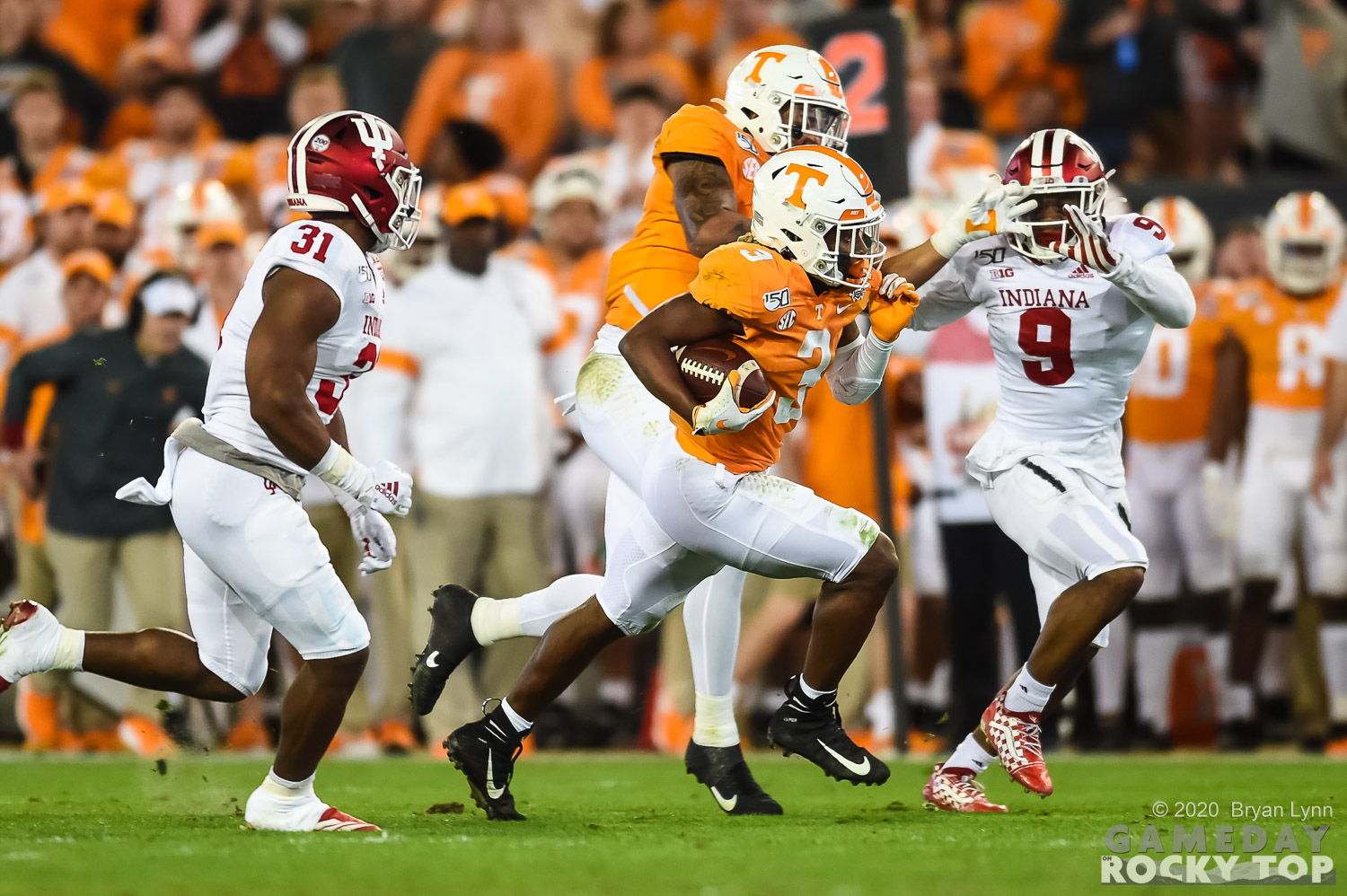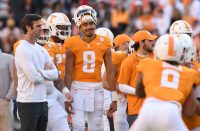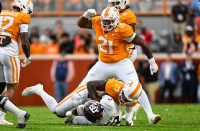It’s almost magazine time – more on that soon from Joel – but this week our writing staff had a conversation on this year’s cover and title. After the Kiffin/Dooley era and Butch Jones’ first season, we – as writers and fans – have spent many of the last six summers asking some form of the same question: “Okay, we’re going to make progress this fall, right? But how much?”
Now on our fifth coach in the last 13 years, the same length of time between our last division title and now, I find a lot of the necessary patience is now built in to that question. The majority don’t look at the 2020 Vols and their 2020 schedule and use the “back” word with large swaths of confidence. That’s never been a fruitful pursuit in the first place, the 90’s now three decades gone. But the hope remains that we will go “forward” this fall. How far?
Setting aside the large list of uncertainties related to the coronavirus, some of the most helpful context for me comes from the same source we use often when talking football. Bill Connelly’s SP+ data is our favorite predictive model for the future, and one of the most interesting when looking back at the past.
In last year’s magazine, we did an adaptation of a story on our site from January 2019, ranking the last 50 years of Tennessee Football in SP+. The metric itself goes back to 2005, but in 2016 Connelly developed estimated SP+ ratings all the way back to 1970. The primary takeaway from our story: to show just how far the Vols fell in 2017, the worst Tennessee season of the last 50 years by a healthy margin. That framed Jeremy Pruitt’s initial work, which still finished third-to-last in SP+ since 1970, but represented significant progress over the year before. Pruitt’s rebuilding task is historically most similar to what the Vols were trying to accomplish in the early 1980’s, which Johnny Majors ultimately paid off in 1985.
That story used percentile ratings: the 2017 Vols were in the 17th percentile, while Tennessee’s best teams of the last 50 years were in the 95th-98th percentile all-time. But in framing 2020, I find it helpful to just use the actual SP+ data from the last 15 years. In this year’s preseason SP+ ratings, the Vols earned a 14.7 (points better than the average team on a neutral field). How does that compare to the last 15 years of Tennessee football?
Working backwards through the list, we get:
The Bottom
- 2017: 1.2 SP+ rating (points better than the average team on a neutral field)
No need to dwell here: total collapse to 4-8, blown out by Missouri and Vanderbilt, no other option but change.
The First Year (or Years 0 & 1 for Dooley)
- 2013: 5.1
- 2018: 5.5
- 2011: 6.9
- 2010: 7.7
Not much surprise here either: the first seasons for Dooley, Butch, and Pruitt, plus an injury-riddled second year for Dooley. One other common theme here: all four of these teams faced particularly difficult schedules. Dooley and Butch got Oregon in year one, Pruitt got West Virginia. Dooley’s second year, the last of facing two rotating SEC West opponents, saw the Vols get #1 LSU and #8 Arkansas. Butch got the Kick Six Auburn team in year one; Pruitt got (and beat) a ranked Auburn team in year one.
Fulmer’s Down Years Are Now Our Year 2
- 2019: 10.7
- 2008: 12.0
- 2014: 12.2
- 2005: 12.3
Last season is at the bottom of this tier; not a bad accomplishment considering what happened in September. The 2019 Vols would be five point favorites over the 2018 Vols, themselves four point favorites on their 2017 counterparts. The 2008 Vols had the nation’s number one defense in SP+…and the Clawfense finished 97th. Butch’s year two died against Florida but was resurrected by Josh Dobbs. And the 2005 Vols got sick on the quarterback carousel with injuries just as contagious.
The good news about this tier: in all four of these cases, Tennessee was significantly better the next season.
We Have a Chance to Win This Game
- 2020: 14.8 (preseason projection)
- 2012: 15.1
- 2009: 16.2
- 2016: 16.3
The preseason SP+ ratings put the 2020 Vols as four points better than their 2019 counterparts on a neutral field. That means they’d be two touchdown favorites on the 2017 Vols. Not bad work from Jeremy Pruitt going into his third year.
What’s the common theme in this tier? I think it’s competitiveness: not with Missouri and Vanderbilt, but with everyone. In 2009, 2012, and 2016, only against Alabama in 2012 should the Vols truly have had no shot. Some of these games turned into nice surprises for us (Kiffin vs Florida and Alabama). Some of them went very differently than we thought at kickoff the other way (Dexter McClustered in 2009, Dooley’s last hurrah at Vanderbilt, South Carolina and Vanderbilt in 2016).
Remember for 2016 in particular, this rating takes the entire season into account. In preseason, the 2016 Vols were at 19.2 in SP+. Those three points could’ve made a difference against Texas A&M, South Carolina, and Vanderbilt. So you’ll also note this tier features records from 5-7 to 9-4. Now, I don’t think the 2020 Vols are looking at 5-7 unless there are catastrophic injuries. But herein lies the beauty of SP+: every play counts, and it’s meant to give you an idea of a team’s strength, not the value of their resume. Not all 9-4’s are created equal, as we learned under Butch Jones. In this group you also had total breakdowns on the defensive side of the ball in 2012 and 2016 tied to new coordinators, another plus for the 2020 Vols who bring back the same faces.
So this becomes a helpful framework for 2020: can I come to kickoff thinking we have a chance to win every Saturday? This group had its flaws, but I do think they’re at least a half-step above, “Can beat anyone and be beaten by anyone.” You’re still going to get an upset here and there. But for teams on this level, you could believe victory was possible every week.
Competing For Championships
- 2006: 18.9
- 2015: 19.5
- 2007: 20.2
The step beyond for Tennessee: get back to Atlanta. The 2007 Vols did it. The 2015 Vols were one play(s) away against the Gators from doing it. And the 2006 Vols were ranked eighth in November before Erik Ainge got hurt.
Here again, this framing is more fruitful to me than chasing memories of the 90’s. And here again, each of these teams lost four games. But their relative strength was a step above what we saw in the previous tier: that group we expected to compete, this group (which is where 2016’s preseason numbers would go) we expected to win.
To me, the question isn’t about whether the Vols can break into this tier in 2020. If they do the work well in the previous tier – competitive with Oklahoma, Florida, Alabama, and Georgia – they’ll have a chance for clear success and progress.
Of course, these numbers are all about predicting your ability to win. The most important thing is to actually go do it. Hitting what feels like the top portion of realistic projections for 2020 – win one of those four big games and don’t get upset by anyone else – and following it up with a Citrus/Outbackish bowl victory would put the Vols at 10-3. Tennessee hasn’t won 10 games in a season since 2007, and hasn’t ended a year with less than four losses since 2004. That would be a tremendous accomplishment.
The wins will always matter most. But Pruitt has done a good job getting forward progress from the Vols from the bottom of 2017. There should be more of that on the way this fall. How much?
If I can come to kickoff 13 times this year and believe we’ve got a real chance to win, that’s a really good start. If this team can finish off some of those wins, the Vols will keep this whole thing moving forward.




